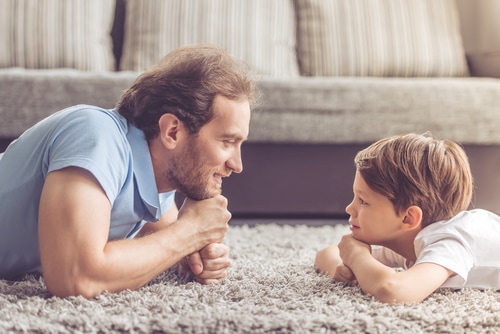Too many parents and caregivers shy away from talking to kids about private parts and body safety rules because they believe that it means sitting down and talking about sex. They focus more on what they fear (explaining what sex is and the idea of sexual abuse) and not enough on what they love and want to protect (their children). Even schools and youth organizations are often more concerned with navigating the proper way of addressing this issue to avoid offending parents, instead of focusing on the reality that there are children under their care that will benefit from this information.
But if we take the time to really educate ourselves, we’ll realize this is so much more than a ‘talk’, it’s a culture change. The reality that an estimated 1 out of 4 girls and 1 out of 6 boys are affected by sexual abuse is almost more than we can comprehend. It’s shocking. But perhaps even more shocking that there isn’t more being done to prevent it. When children do disclose some are not believed and do not receive help, and even more disturbing offenders often are never prosecuted, let alone convicted.
This isn’t something for parents who worry about every little thing. This is for people who have the common sense to accept that this is very real and very serious and denying it won’t make it go away.
It’s putting safety first, it’s education that children deserve, it’s empowerment that benefits beyond prevention. And perhaps most rewarding, parents that embrace body safety often have stronger, more connected relationships with their children. A child that knows they can talk to their parents about anything, especially their bodies, is much more likely to have higher self esteem, exercise skills to identify possibly dangerous situations, and disclose abuse sooner.
So how do we do it? How do we take such a scary subject and talk about it with our children and the adults we know?
If you’re uncomfortable with using the proper names for genitalia, start early and just keep using them as part of your vocabulary – during bath time, diaper changes etc., until you realize: they’re just words. Certainly, we have bigger issues in our lives than hearing the proper terms for our body parts, right?2. Keep it Casual
We teach our kids so much, don’t we? How to share, button a shirt, ride a bike – why should educating them about how wonderfully special and private their bodies are be any different? We talk to them about fire safety, walking with scissors, and crossing the street – so what’s the big deal to include their right to know what kinds of touches are appropriate and which are inappropriate, and such issues should never be kept secret? We are their protectors – we are teaching them one way or the other; if we say nothing they’re much more likely to say nothing, too. It’s our responsibility to give them the information they need to stay safe and understand what respectful, appropriate relationships look like.3. Keep it Common
You might be amazed how often you can talk to kids about consent, keeping privates private, the importance of listening to our instincts, and not keeping secrets from us. Kids having a tickle fight or that great aunt that wants to snuggle your shy child? Great opportunity to talk about respecting other people’s bodies and that even children have a right to decide how their body is treated or touched. Talking about the importance of ‘privacy’ when people are using the bathroom, changing clothes. Although children often need help with these tasks, as they become able we can promote privacy by asking if they’d like us to close the door while they use the toilet, or encouraging them to wash themselves in the bath when they’re old enough. Or encouraging them to give us adults privacy when using the bathroom (the struggle is real, we know).4. Get a Book
There are a number of body safety books out there. Build them into your regular rotation, whether you get them from your local library or buy a few as a gift. Not only does it take a little pressure off of us to bring up these concepts and talk about it, it also normalizes these conversations, and can help children learn through the added visual impact. (We also have free coloring pages you can print any time.)
5. Keep it Real
While not every sexual abuse case make to our local news (and sometimes we can’t bear to watch the news these days), many stories regarding sexual misconduct (by adults or minors) from across the country come up on a daily basis, rarely do they involve strangers but trusted family members, coaches, and classmates. Talking about these situations with our family, friends, and older children can help make it real, not just some ‘thing’ they’re being taught, that there is a reason why we prioritize education and appropriate, respectful behavior.
No, not everyone is going to want to hear about it. There will be naysayers, deniers, those that blame children for not being able to protect themselves. There’s a term for this dangerous mentality: Willful Blindness. Sexual abuse can be prevented, but not if we refuse to face the truth. The angerous taboo that surrounds this issue grows in silence. If you are reading this, you absolutely have the power to protect children: your voice. Do not surrender it. Rock the Talk™.





